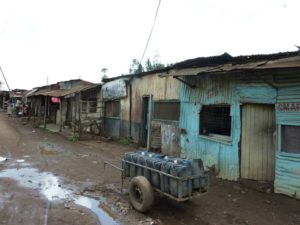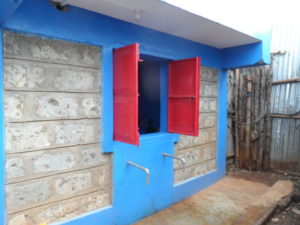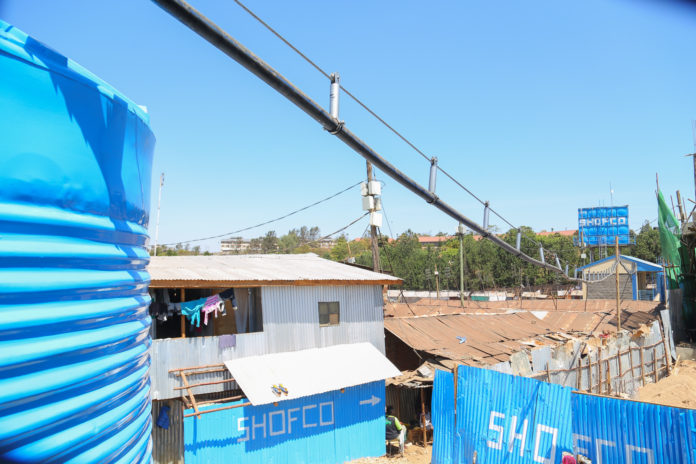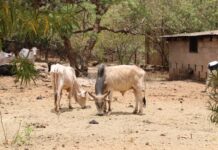|
Getting your Trinity Audio player ready...
|
By Henry Owino
Like in many other slums and shantytowns around the world, water is scarce, costly, uncertain and most of the time it is contaminated, this is the same in Nairobi’s informal settlements.
In Kibera, one of the largest slum in Nairobi, and the largest urban slum in Africa, this water crisis is particularly severe for many reasons. One noticeable reason is that of its informal settlement that is built without any official authorization and regulation from the government.
The others are a combination of the stronghold of government opposition and political exclusion from regimes that have been in power. These have lead to the operation of water cartels, water rationing, and poor infrastructure hence consistency of inadequate access to safe water and poor sanitation.

Residents who live in these overcrowded shacks, poor sanitation and poverty are widespread as government officials have traditionally ignored the community. With the absence of clean and safe water, poor quality houses, insecure and dilapidated environment makes it hard to live in the deplorable setting.
Kibera is located just five kilometers from Kenya’s vibrant capital Nairobi and bursts with a population of an estimated one million residents who form one-fifth of Nairobi’s population.
The good news though, is that there is a sigh of relief as close to 200,000 residents of Kibera slum, now will have access to clean and safe water. This follows an innovative aerial clean and safe water distribution system that was commissioned two years ago.
The aerial distribution system was designed in June 2016 by Shining Hope for Communities (SHOFCO), a local development non-governmental organization and one of the largest NGO operating in the slum.
According to Kennedy Odede, the Founder, and CEO, the NGO has been running health clinic services, empowering girl-child education, environment, and sanitation projects and empowering community as a whole since 2011.
Odede, however, revealed that most residents suffered from stomach related to waterborne diseases as result of drinking contaminated water. For example, dysentery, typhoid, and cholera were major health hazards cases frequently reported and treated at SHOFCO clinic.
“Water supply project came as results of persisted waterborne ailments, shortage, disconnections and cartels controlling its prices,” Odede stated.
Odede disclosed SHOFCO came with a lasting solution which is alternative piping water supply that is affordable, available, clean and safe for residents. The overhead piped water was an absolute decision made as the best answer to fight various prominent waterborne diarrheal diseases.
The organization approached several private organizations for financial support and Safaricom Foundation came in handy. The leading mobile subscriber in Kenya donated Ksh 12 million towards the aerial piping water project.
“We settled to overhead piping design because it provides a rapid deployment option as it does not involve trench digging and underground pipe laying” Odede explained. We wanted technology that assures clean and safe water at an affordable price for poor slum dwellers,” he added.
Odede regretted Kibera residents used to pay more for unsafe water compared to wealthier Kenyans with tapped water within neighborhoods of Nairobi. However, currently, that problem has been sorted once and for all.
Mary Akinyi, 32 slum’s resident living at Mama Okinda village, admits that since the overhead piped water was fixed, stomach problems have reduced. She proudly states the new technology has saved residents more than they expected.
Akinyi stated water is clean and safe, low-cost, accessible, no long queues and available almost all time. Women fetch it at their convenient hours in the day.
“Since the installation of these overhead pipes in 2016, cases of bloody diarrheal infection rates in Kibera have significantly been slashed,” Akinyi admitted. I can even drink the water directly from the tap without boiling it.” She added.
“The usual plastic pipes underground or above the ground often crack or break either accidentally due to human traffic. Intentionally by competitors who broke pipes to allow sewage leak in so that people buy from them,” Akinyi revealed.
Susan Auma, aged 42 has lived in the slum’s Kisumu Ndogo village for 30 years now, she is one of the water vendors employed by SHOFCO. She affirms the overhead water is affordable, easily accessible and free from contamination. She mentioned at least 30 water points available at strategic locations in 9 villages out of 13 in Kibera.
“The water is rarely rationed thus available on a daily basis at Ksh2 per 20 liters jerrican. It is now affordable to most residents compared to Ksh 10 or more as cartels sold it,” Auma ascertained. The Ksh10 now gives you five jerricans that are 100 liters.” She adds.
“Diarrheal diseases have drastically reduced in the slum. We save on money for buying paraffin to boil drinking water, we no longer have long queues neither spend 1 hour searching for water whereabouts,” Auma explains joyfully.

The 30 water vending kiosks are strategically placed and connected to supply the 9 villages within Kibera slums. These are Gatwekera, Soweto West, Kisumu Ndogo, Raila estate, Darajani, Silanga, Kianda, Mama Okinda and Lindi. The villages left out are Makina, Mashimoni, Laini Saba and Soweto East yet to be connected.
“The aerial piped water has reduced chances of effluent mixing with clean water thereby contaminating it. Again sabotage through disconnections or blocking free water flow by illegal competitors is now resolved,” Auma asserts.
Beatrice Mokeira from Soweto West village recalls originally women and children of Kibera could spend all day searching for water. Today, close to three years, that is history to her and family as SHOFCO overhead piped water technology solved their problems.
“Women used to walk long distances in search of clean water and at low-cost as far as Jamhuri estates next to Show Grounds,” Mokeira states.
“If they missed clean water or if the price of water found was too high, they would consume substandard water from a free yard tap or from natural spring most of which are contaminated and unsafe for drinking,” Mokeira explains.
Mokeira lamented it forced them to boil another extra cost. Predominantly, water in Kibera slums cost Ksh 10 to Ksh 50(USD 10- 50cents) for every 20 litres of jerrican depending on the season, dry or wet spell. Other reasons were its availability, accessibility, source and distance the handcart vendors has covered transporting it.
Mokeira regretted: “Most water sources were not known even though it looked pure and clean. Water from underground pipes smelled sewage due to cracks which seep in raw sewage hence unsafe. Yet some vendors supplied it to innocent consumers, many who drank it without boiling.”
According to Veronica Asusa from Lindi village, women and children of Kibera spent a lot of time locating water vendor, queuing up, and carrying back the water. She said on a good day, the whole process took one hour.
“We fetched 20 liters jerrycan at between Ksh10 -20 while handcart vendors would sell it between Ksh 30-50 with same applicable reasons,” Asusa confirmed.
“Several water vendors were cartels who used to sell water whose sources were either unknown or from disconnected pipes. Fortunately, this aerial piping technology has phased them out,” Asusa explained. Residents no longer scramble for water queues as water vending points are not only many easily accessible but available all time.” She added.
“Again we are not paying exorbitantly fee as we used to. The Ksh 2 for 20 liters jerrican has been consistent for the last two years to date regardless of the season. This new innovation by SHOFCO is a safe haven to our water dilemma in Kibera” Asusa emphasized.
“In fact, women are much relieved from the quagmire of financial indebtedness, fear being raped early in the morning or late in the evening”, she added.
The new water technology has also offered job opportunities to the women and youth who work as vendors and security guards in various water points. Cases of women being raped in corridors as they search for water are no longer there.
In other slums like Mathare, Korogocho, Muruku, and Dandora the same water vending points have been adopted. Although the pipes are underground, residents are employed to man them by Nairobi City Water and Sewerage Company (NCWSC).
The NCWSC partnered with Danish Water Engineering Company, Grundfos to provide clean and safe water to these informal settlements.
The two companies came up with water dispenser ATM kiosks that provide clean and safe water to the residents at Ksh 1 per 20 litres jerrican. The water is available throughout the day except during normal rationing seasons of the dry spell.
This is much cheaper than the rates being charged by the traditional water vendors who are expensive and unhygienic. The new ATM system allows residents to use a smart card instead of cash thus assures transparency and accountability. The smart cards works just as the mobile phone airtime cards where consumption depends on the user.
According to Nanashon Muguna, Managing Director of NWSC, the rationing of water three times a week is to balance water distribution. It happens during dry weather and due to high capital involved.
Although NWSC recommends that the price for a jerrycan of 20 litres of water be Ksh 1, so even at Ksh 2, residents of Kibera pay eight times the lowest tariff at domestic connections and four times the average tariff in Kenya.
“One of the many reasons why water is too expensive is because illegal water vendors who want to make quick money. They sell or charge customers according to distance and energy used to ferry it from NWSC sources,” Muguna disclosed.
“Most water pipes in the slums run above ground and are made of highly fragile plastic which is easily manipulated. The cracks in pipes compromise water quality greatly hence complicate safe water delivery systems,” Muguna regrets. We are using metallic pipes dug underground for safe supply.”
According to Dr. Kepha Obacho, Director of Public Health and Sanitation, Ministry of Health, waterborne diseases are caused by drinking contaminated or dirty water. Contaminated water can cause many types of diarrheal diseases, including Cholera, and other serious illnesses such as Guinea worm disease, Typhoid, and Dysentery.
Dr. Obacho cautioned that water sources that look generally clean can easily become contaminated without notice. This is because microbes are so tiny to be visible by naked eyes, so boil drinking water before use.
He alluded to proper household water and sanitation practices can increase resilience to waterborne disease risks. These measures include correct sanitary sewage disposal, safe water piping materials and storage, and civic education on hygienic behaviors, especially in slums.














